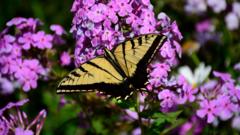Research from Binghamton University highlights drastic population declines in butterfly species, urging both conservation initiatives and policy changes to support their recovery and sustain ecosystems.**
Alarming Butterfly Decline in the US Calls for Urgent Conservation Efforts**

Alarming Butterfly Decline in the US Calls for Urgent Conservation Efforts**
A new study reveals a staggering 22% reduction in butterfly populations across the United States over the past two decades, emphasizing the need for immediate action to protect these vital pollinators.**
According to recent research conducted by Binghamton University, butterfly populations in the United States have experienced a worrying decline of over 22% in just two decades, signaling an urgent need for conservation actions. The study, which analyzed 12.6 million butterfly sightings from 76,000 surveys across 35 monitoring programs, reports that approximately one-third of butterfly species are suffering significant population losses, with some, like Julia's Skipper, facing declines exceeding 90%.
The findings, published in the journal Science, highlight a troubling trend where 33% of the examined butterflies are in serious decline, including 107 species that have witnessed reductions of over 50%. Prof. Eliza Grames, an assistant professor at Binghamton University, stated, “While the results aligned with global trends, seeing the extent of the decline at such a large spatial scale was sobering.”
Among the most imperiled species are the Florida white, Hermes copper, tailed orange, Mitchell's satyr, and West Virginia white, all suffering declines greater than 98% in abundance. Alarmingly, even the adaptable West Coast lady butterfly has diminished by 80%, suggesting that even common species are not immune to the threats at hand.
The primary drivers behind these declines include habitat loss, pesticide use, and climate change, which pose significant risks to butterflies—crucial pollinators vital for plant and crop support. Experts stress that the loss of butterfly populations can disrupt entire ecosystems and food production systems, as they serve as important indicators of environmental health.
The Southwest region of the US has been particularly hard hit, with drought identified as a key factor affecting butterfly numbers. Prof. Grames explained that drought impacts butterflies directly while also influencing their food and host plants. The study's results could catalyze conservation efforts, helping to prioritize species for inclusion in the International Union for Conservation of Nature (IUCN) Red List and the Endangered Species Act.
Despite these alarming trends, there is a glimmer of hope for recovery. According to researchers, butterflies can rebound quickly due to their short generation cycles. Simple actions, such as planting wildflowers, reducing pesticide use, and maintaining natural areas in yards, can greatly enhance their survival prospects. Prof. Grames also noted the essential role of government actions in creating policies that foster insect conservation. "Insects are fundamental to life on earth, and we need conservation actions and policies that support insects," she concluded.





















